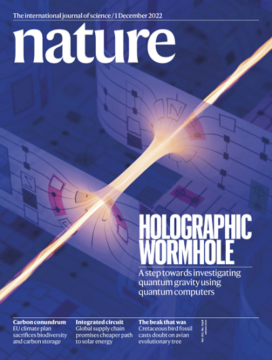by Eleni Petrakou

It’s late 2022. Scientists announce the creation of a spacetime wormhole. A flurry of articles and press releases of the highest caliber spread the news. Involved researchers call the achievement as exciting as the Higgs boson discovery. Pulitzer-winning journalists report on the “unprecedented experiment”. US government advisory panels hear it is a poster child for doing “foundational physics using quantum information systems”. Media the world over are on fire.
All the while, the scientific community is watching, dumbfounded.
Because, of course, nobody had created any spacetime wormhole.
*
Now that all the rage is well gone, it’s probably worthwhile to revisit that episode with the proverbial hindsight.
Specifically, the events of November ’22 kick off with an article in Nature detailing the creation of a “holographic wormhole” in Google’s quantum labs. On the same day, the prescheduled publicity by respected science outlets is crazy –the announcements by participating elite universities don’t hurt either– and sure enough the story quickly makes headlines all across muggle media.
To keep things in context: in case you are wondering if wormholes are something whose existence would shake a large part of what physics we know and, even if they exist, we might be technological centuries away from their handling, you are right. This is why all experts not connected to the study reacted with unbridled skepticism.
For certain, moderate coverage appeared alongside hype from the start, and probably even outnumbered it. Several news stories pointed out that we are talking about nothing more than calculations of a theory involving wormholes executed on a quantum computer, let alone the actual traversal of spacetime discontinuities. (And not even calculations that classical computers can’t perform equally well, while at it.) Sadly, the reality of it all was too abruptly anticlimactic to even leave room for speculation on whether some kind of breakthrough was achieved. The only speculation among experts seemed to be on how this outbreak could ever happen in an area such as physics.
*
More on this last question in a while. First, a look at the developments that followed. It will be a quick look, as the only notable developments were a paper in February ’23 pointing out mathematical issues with the study, and a reply by its authors. (A historian of modern physics wrote that the reply is a creative attempt to rescue the relevant math “from its inevitable fate of being invalidated”; she also took care to stress that the wormhole’s modeling does not represent an actual teleportation.) There were no reported updates or new media mentions since, unlike what one would expect for a groundbreaking technology, save a couple of critical takes.
*
So, what was learned from the events of late ’22? Nothing, I would say, but in two different ways.
For one, there was nothing really new to begin with. Around the same time as the wormhole creation, I was strolling downtown, accidentally hearing two “girls next door” behind me sharing their troubles; suddenly, a change in tempo; one of them regains some hope. “But, you know, how scientists say that there are other universes where our different selves are found…”
Throughout this century, the public has been informed with reassuring consistency about the success of scientific theories uncovering extra dimensions, extra universes or even extra timelines. What harm would a small tunnel in spacetime do?
But there is also the other nothing, the one that was literally learned.
Early last month, the fifteenth edition of the World Science Festival took place, an annual event run by prominent academics-cum-science communicators. One of its sessions was partly dedicated to the wormhole study, with its three main authors on the panel – although their work was modestly described as “speculation”.
Incidentally, a video by a respected science outlet which led the promotion in ’22 has had its description updated. It now informs that the ’23 paper showed that there never was any wormhole created. Implicitly stating that, before that paper, it was okay to believe that there was a wormhole created. (It also attracts many comments newer than one year about how this work is worth a Nobel prize.)
*
Closing personal thoughts by this physicist? The scientific discoveries of the last century, as well as those that keep coming, are downright stunning. Yet, somehow, at least for physics, as a rule their epistemic value is downplayed when world-class academics tell the public about them: what we imagine we don’t know yet takes center stage, displacing the cracking truths we now do know. Furthermore, very often what we imagine we don’t know is declared to be unknowable, corroding the collective scientific mindset in the process. With this fertilizer, the ground is quite conducive to shiny false truths.
Keeping it real and channeling Douglas Adams, only this time talking about a very different field than the paranormal, isn’t it enough to see that science is beautiful without having to believe that there are unfounded claims at the bottom of it too?
